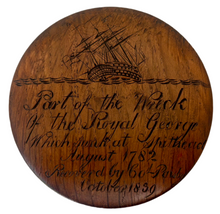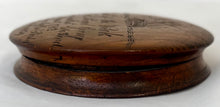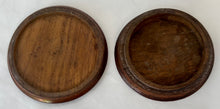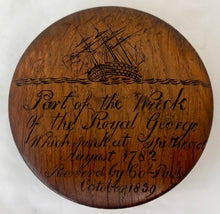
HMS Royal George Treen Snuff Box Recovered from the 1782 Wreck at Spithead. On 23rd September 1839 General Sir Charles William Pasley KCB FRS Detonated 2300 lbs of Explosives Against the Wreck of the Royal George. Lieutenant Robert Strickland Thomas Captured the Explosion in a Painting.
The text to the cover reads: 'Part of the Wreck of the Royal George which sunk at Spithead August 1782, Recovered by Col Pasley October 1839'.
The Royal George was a 100 gun ship of the line built at Woolwich Dockyard and launched in 1756. She saw active service during the Seven Years War, taking part in the 1757 Raid on Rochefort. Admiral Hawke used her as his Flagship at the Battle of Quiberon Bay in 1759. The Royal George was laid up for 14 years before serving in the American Revolutionary War as Admiral Robert Digby's Flagship at the 1780 Battle of Cape St Vincent.
On 29th August 1782, whilst anchored at Spithead, she was intentionally rolled in order for her hull to be maintained. The roll became unstable and she took on water, sinking with the loss of over 800 lives.
In 1839 Colonel Charles Pasley of the Royal Engineers commenced operations to break up the wreck using barrels of gunpowder. Pasley's team recovered more guns and other items between 1839 and 1842. In 1840, they destroyed the remaining structure of the wreck in an explosion which shattered windows several miles away in Portsmouth and Gosport.
Approximate dimensions are 8.8 cm diameter and 1.8 cm height.
Approximate weight is 47 grams.
In good condition with no losses or repair. The box is a bit warped, so a little ill fitting to one side as per the photos.


















